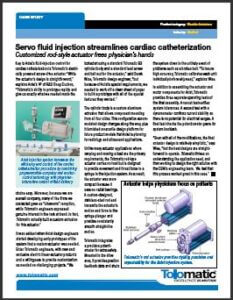Servo Fluid Injection Streamlines Cardiac Catheterization
Servo fluid injection streamlines cardiac catheterization
Customized rod-style actuator frees physician’s hands
Key to Acist’s fluid-injection control for cardiac catheterization is Tolomatic’s electrically powered screw-drive actuator. “While the actuator’s design is straightforward,” explains Acist’s VP of R&D Doug Duchon, “Tolomatic’s ability to prototype rapidly and give us exactly what we needed made the choice easy. Moreover, because we are a small company, many of the firms we contacted gave us “lukewarm” reception, while Tolomatic engineers expressed genuine interest in the task at hand. In fact, Tolomatic actually built a custom extrusion for this actuator.”
It was evident when Acist design engineers started developing early prototypes of the system that a custom actuator was needed. Enter Tolomatic engineers, with new and exclusive electric linear-actuator products and a willingness to provide customization as needed on challenging projects. “We looked at using a standard Tolomatic B3 cylinder body and a standard lead screw and ball nut for the actuator,” said Derek Wise, Tolomatic design engineer, “but because of Acist’s special requirements, we needed to work off a clean sheet of paper to build a prototype with all of the special features they wanted.”
The cylinder body is a custom aluminum extrusion that allows component mounting from all four sides. This configuration accommodated design changes along the way, plus it furnished a versatile design platform for future product models that Acist is planning for radiology and ultrasound applications.
Unlike many actuator applications where carrying and moving a load are the primary requirements, the Tolomatic rod-type actuator carries no load but is designed to provide movement and thrust force to a syringe in the injection system. As a result, the actuator was more compact because it uses no radial bearings. A custom-designed, stainless-steel rod end transmits the actuator’s motion and force to the syringe plunger and provides consistently smooth straight-line motion.
Tolomatic integrates a precision potentiometer for extra safety. Mounted in the drive area, it provides position feedback data and shuts the system down in the unlikely event of problems such as a broken belt. “To insure high accuracy, Tolomatic calibrates each unit individually before shipment,” explains Wise.
In addition to assembling the actuator and motor components for Acist, Tolomatic provides three separate operating tests of the final assembly. A runout test verifies system tolerances. A second test with a dynamometer confirms current stability so there is no potential for electrical surges. A final test checks the potentiometer gears for system backlash.
“Even with all of the modifications, the final actuator design is relatively simplistic,” says Wise, “but the best designs are straightforward to operate. Tolomatic thrives on understanding the application need, and then working to design the right solution with the OEM’s engineering team. We feel that this process worked great in this case.”

 Kontakt zu einem Ingenieur
Kontakt zu einem Ingenieur